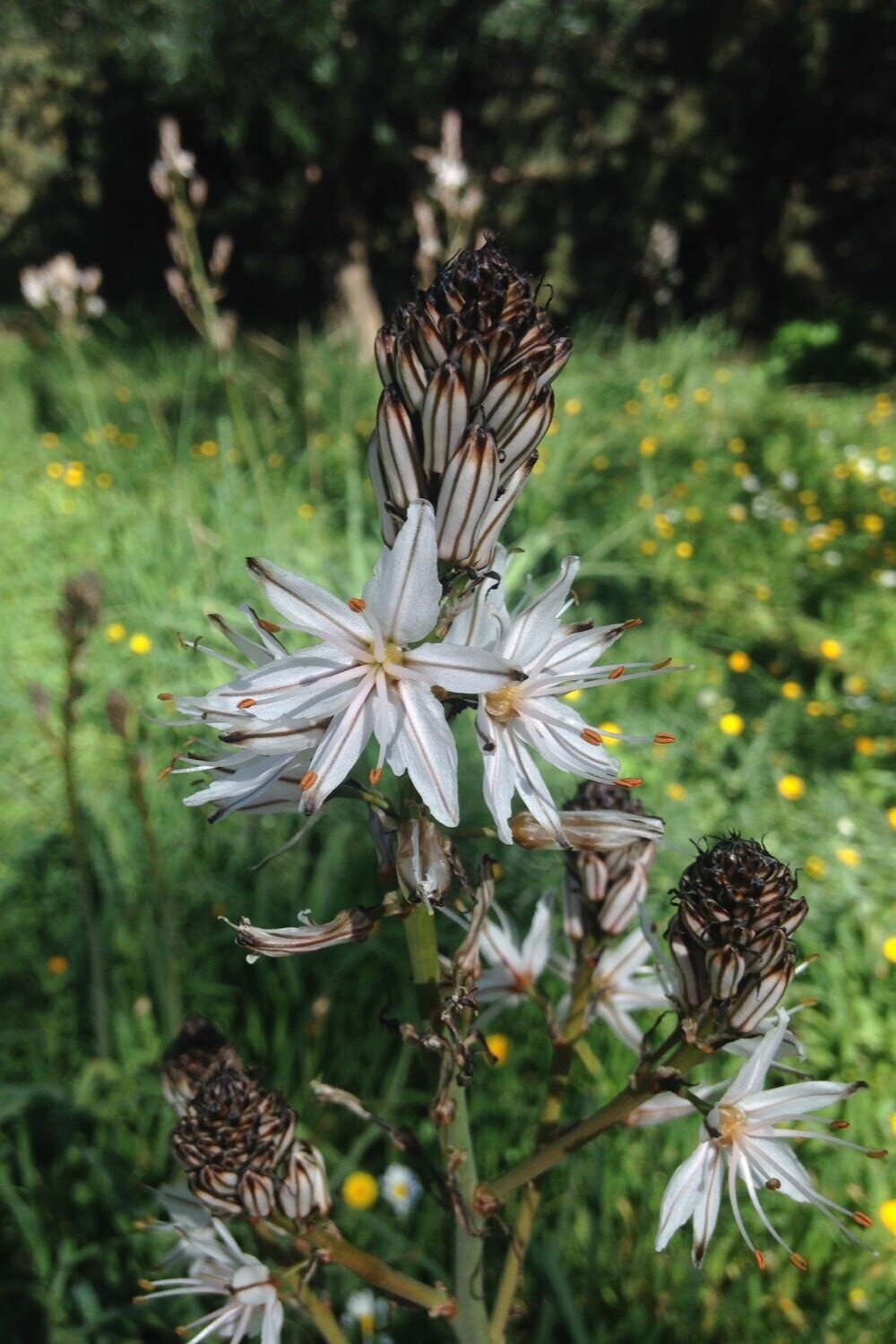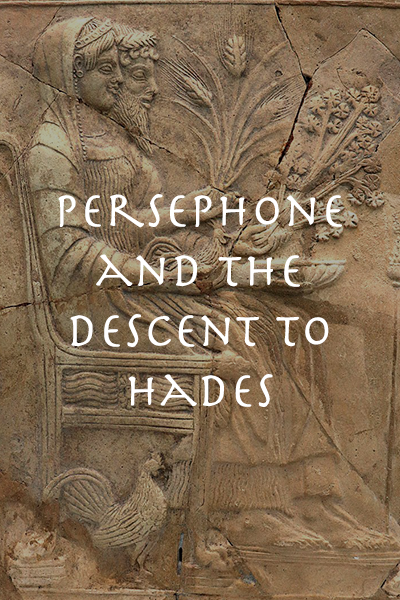Asphodel
Asphodelus spp., Asphodeline spp.
Gateways - Thresholds - Transitions
The Asphodel is a hardy, herbaceous perennial with star-like white or yellow flowers growing on a single or branching tall spike. Blooming in early spring, they are often found in large colonies or clusters along the edges of disturbed areas, in fields and sometimes on stony ground. As an herb associated with Persephone and Hekate, it is easy to imagine Asphodels as torches, illuminating the way to and from the Underworld with their glow. Existing as they do on the borders and aligned with the dark and unseen realms, the Asphodel is a powerful ally for traversing unknown territories and navigating contradiction. Keep reading below to learn more about the Asphodel.
Index
The Asphodel in the Wild & Garden
LATIN BINOMIAL
Asphodelus spp.: The main three species found in Greece are the A. aestivus (Common Asphodel), A. albus (White Asphodel), and A. fistulosus (Hollow-Leaved Asphodel). Leaves are at the base of the stem and flowers are white or white-with-pink.
Asphodeline spp.: The two main species found in Greece are the A. lutea (Yellow Asphodel) and A. liburnica. Narrow leaves are found along the length of the stem and flowers are yellow.
Note: Asphodel is also the common name for other plants not in the Asphodelaceae Family.
PLANT FAMILY
Asphodelaceae
COMMON ENGLISH NAMES
Asphodel, Jacob’s rod, King’s spear
COMMON GREEK NAMES
Ασφόδελος
CHARACTERISTICS
hardy herbaceous perennial with tall flower spikes
NATIVE HABITAT
Mediterranean and temperate Europe
PREFERRED CLIMATE & CONDITIONS
Full sun. Hardy from Zones 6 to 10. Various species are found in the Greek wild from coastal regions up into the high mountains, often forming large communities in stony, infertile, or disturbed locations
TYPICAL HEIGHT AND SPREAD
Can grow up to 1.2m (3-4 feet)
BLOOM COLOR AND CHARACTER
Tall spike of white (Asphodelus spp.) or yellow (Asphodeline spp.) flowers with six petals, blooming late March to June. Asphodelus fistulosus petals can have a slight pink tinge.
This will be my first year living close enough to a wild Asphodel community that I can observe the same plants as they change through the Seasons. Subscribe to the Parchments here to be the first to know when I update this Materia Mythica entry with new images and information about inviting the Asphodel into your garden.
The Asphodel in Greek Mythology
The Underworld
The Asphodel has long been associated with the Underworld. In the Odyssey, Homer described the realm of the dead as an “asphodel meadow,” and many poets (both ancient and modern) interpreted this to mean that the afterlife of the ancient Greeks was a beautiful, lush place full of springtime flowers.
But this paradisiacal, flowery afterlife seems at odds with Homer’s other depictions of Hades’ realm: a dark and gloomy place where regular mortals wander, wailing, lost, and aimless. Most contemporary sources try to justify this connection by saying that it is the Asphodel’s “ghostly” appearance and “grey-green” leaves, as well as its tendency to grow in disturbed or even rocky areas, that solidify its link to the Underworld.
But anyone who has met the Asphodel in person knows that it is anything but ashy or grey. Asphodelus spp. are white, yes, but they are far from “ghostly,” with a gorgeous flower spike of star-like flowers reaching up to the sky. They look to me more like candles or torches, a field of flames against the sky. And while Asphodel can grow in disturbed and stony ground, I’ve also seen them in lush green areas, usually along the borders of fields or paths, blooming wildly with other bright, springtime flowers for company.
So what are we to make of this contradiction? On one hand, Homer’s Underworld is depicted as a dark, gloomy, and desolate place for regular mortals. And on the other, the Underworld is associated with springtime flowers blooming in lush fields.
Linguist and historian Steve Reece makes an interesting argument in his article Homer’s Asphodel Meadow that “the solution lies rather in a very ancient (i.e., pre-Homeric) association of the asphodel with the afterlife—though not necessarily with the underworld—an association that may go back to the indigenous culture from which the Greeks borrowed both the flower and its name” (p395). He continues, “like most cultures throughout human history, both ancient and modern, the Greeks held complex and sometimes contradictory views about the afterlife…This complexity was probably a result of the syncretism of several different cultural traditions” (p397).
I actually see this complexity as an essential aspect of the Asphodel’s nature. It is a flower that stands on the threshold: between cultural traditions, between Seasons, between landscapes, between the realms of life and death…
Persephone and Hekate
Pausanius says that on Rhodes, statues of Kore-Persephone and Artemis-Hekate were crowned with Asphodel, linking the flower to two liminal goddesses associated with thresholds and the birth-death mysteries.
Like the Asphodel, Persephone holds contradiction in her very nature: she is both a youthful spring-maiden, as well as a powerful ruler of the dead. But it is that very nature that allows her to cross the threshold between the living and the dead twice a year. And let us not forget that Persephone was in fact picking springtime wildflowers (specifically, the Narcissus, but quite possibly the Asphodel) when Hades forced her through a rite of passage from youthful freedom to Queendom. (Interestingly, in English, the word daffodil is even derived from the word asphodel, and sometimes the Narcissus is referred to as an Asphodel).
Some stories say that after Persephone’s abduction, it was Hekate, the goddess of Crossroads and Gateways, who took up her torches and went seeking the young goddess in the Underworld. And it is Hekate (a goddess who literally holds the key to the other realms in her hand) who opens the gate to the Underworld each spring and autumn in order for Persephone to cross the threshold from the land of the living to the land of the dead, and back again, with the Seasons.
Like Persephone and Hekate, the Asphodel is thus connected with the crossing of thresholds. Aligned as it is with the dark and unseen realms, the Asphodel is a powerful ally for traversing unknown territories and navigating contradiction, and can be called upon to guide us through times of transition.
A Temple Wild PodcastPersephone and the Descent to Hades
Listen to this podcast episode to learn more about Persephone, the youthful spring goddess who was wandering in fields of Narcissus and Asphodel when Hades, the god of the Underworld, came to take her as his bride.
The Asphodel in Ceremony
Gateways - Thresholds - Transitions
Connected as they are with Persephone, youthful Queen of the Underworld, as well as Hekate, that liminal, torch-bearing goddess of Crossroads, the Asphodel can be called upon to guide us through transitions and to navigate through doorways into unseen realms and new realities.
To gaze upon a field of blooming Asphodels is like looking upon a field of white or yellow torches, their tall spires like a flame of stars. (Even the branching Asphodel looks to me like a candelabra.) I imagine Hekate taking up an Asphodel against the subterranean dark, lighting the way for Persephone as she crosses the threshold from Season to Season. Similarly, we can call upon the Asphodel when we are navigating through transitions, especially when the threshold is dark and the new reality that awaits us is unknown or uncertain.
Most of us live in a society that fears descent and the dark and dying aspects of being human. We are often ushered as quickly as possible through discomfort, instead of being taught how to linger in the liminal, often mournful, places of transition and change. Especially when faced with experiences that confound our sense of reality and shake our identity at its roots (like death, the end of a relationship, a sudden career change, or even a natural disaster or pandemic), we tend to have two reactions: be paralyzed by fear or muscle through like a bulldozer, intent on getting to the other side as quick as possible. But the Asphodel sits comfortably in contradiction and liminality and can be a powerful teacher around the birth-death mysteries.
If we have found ourselves, like Persephone, plucked from one reality and forced down a path toward a new one, we can take the opportunity to savour the rite of passage, as scary as it might be. Taking up the light-bearing Asphodel, we can traverse through dark corners of our own psyche with bravery, fully engaged on the path as we walk from one reality to another, even if we are not completely sure where we will end up.
Ceremony
When going through life transitions where the outcome is unknown, the Asphodel can be called upon as a guide and companion through the dark. Holding its shape in our mind’s eye, gazing upon an image of the flower, or visiting the plant growing in the wild or garden, we can wrap our hand around the spike and imagine ourselves taking up a torch to illuminate our path across the border-lands and into the unknown.
Devotion
Whether before your altar or the living plant, sit with your eyes closed and repeat the following devotion, imagining yourself traversing through dark and unknown territories:
Asphodel, torch of Hekate,
guide and guard me as I journey
across the Boundaries and into the Depths
to face the Darkness of the Unknown.
This will be my first year living close enough to a wild Asphodel community that I can observe the same plants as they change through the Seasons. Subscribe to the Parchments here to be the first to know when I update this Materia Mythica entry with new ideas for inviting the Asphodel into your ceremonies.
Back to top
The Asphodel in the Kitchen & Apothecary
I do not have any personal experience using the Asphodel in the kitchen, although M. Grieve’s A Modern Herbal says that the root is edible and was once roasted in fire ash and eaten, boiled and mixed with potato or grains to be made into a bread, as well as used as livestock feed. I’ve also heard you can eat the tender shoots, although I’ve never tried this myself. (Interesting to note: the Asphodel is in the same botanical Order as Asparagus. The ancient Greek word for Asparagus is ἀσφαραγία while the ancient Greek word for Asphodel is ἀσφόδελος. As a prefix, I wonder what is the meaning of ἀσφα- or ἀσφό- and how it links the two together. If there are any Greek etymologists among us, reach out and let me know!).
Grieves also says that the Persians made a strong glue from rehydrating the dried root powder.
Considered acrid and warming, the root was once used medicinally to dissolve growths and Hippocrates includes it in a recipe for burns. Today, it is not commonly used by herbalists for healing.
This will be my first year living close enough to a wild Asphodel community that I can observe the same plants as they change through the Seasons. Subscribe to the Parchments here to be the first to know when I update this Materia Mythica entry with new information for inviting the Asphodel into your kitchen.
















